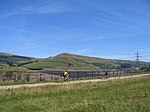Torside Reservoir

Torside Reservoir is the largest man-made lake in Longdendale in north Derbyshire, England. It was constructed by John Frederick Bateman between April 1849 and July 1864 as part of the Longdendale Chain of reservoirs to supply water from the River Etherow to the urban areas of Greater Manchester.The Manchester Corporation Waterworks Act 1847 gave permission for the construction of the Woodhead and Arnfield reservoirs; the Manchester Corporation Waterworks Act 1848 allowed the construction of Torside and Rhodeswood Reservoirs, and an aqueduct to convey the water to the Arnfield reservoir where it would pass through the Mottram Tunnel to Godley. It was stated in a statutory report, under the Reservoir Safety Act 1975, dated 12 June, that all five reservoirs could be overtopped during a Probable Maximum Flood. Woodhead, as the fountainhead, would require the most extensive improvements, but Torside needed crest remedial work. The wave wall was demolished and replaced with one 4 metres (13 ft) above the overflow sill. The claycore was extended to 1.34 m (4 ft 5 in) above overflow sill and the road level was raised to 3.29 m (10.8 ft). The work took place between 1993 and 1994.
Excerpt from the Wikipedia article Torside Reservoir (License: CC BY-SA 3.0, Authors, Images).Torside Reservoir
Woodhead Road, High Peak
Geographical coordinates (GPS) Address Nearby Places Show on map
Geographical coordinates (GPS)
| Latitude | Longitude |
|---|---|
| N 53.482 ° | E -1.904 ° |
Address
Woodhead Road
SK13 1HY High Peak
England, United Kingdom
Open on Google Maps











